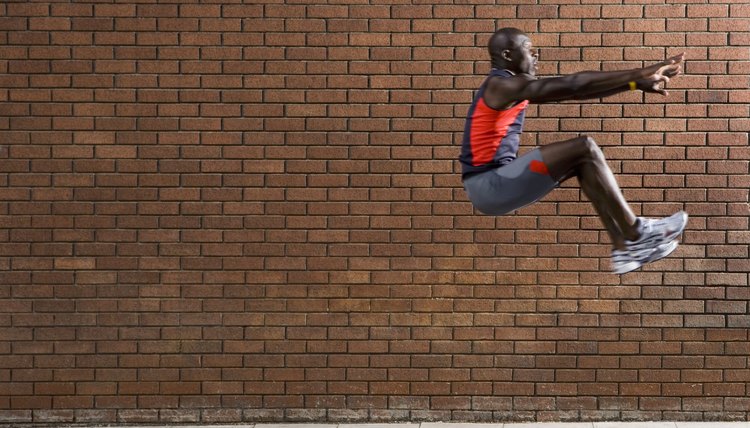Broad Jump & What It Means for Athletes

Broad jumps, also known as standing long jumps, are a bounding exercise used by everyone from track and field athletes to football players trying out for the NFL. Coaches use broad jumps not only to build leg strength in their athletes but also to test leg strength and explosive power. Introducing broad jumps into your athletic training routine can be a highly functional way to improve your overall athletic performance.
Explosive Strength
The biggest benefit of broad jump training for athletes is that it improves the reaction of fast-twitch muscle fibers throughout the body. Like other plyometric exercises, effective broad jumps require your leg and core muscles to contract very quickly so you can generate maximal force with each leap. According to sports physiologist Phil Davies, the squat you take before a broad jump allows you to stretch your muscles and thus generate a more powerful muscle contraction when you jump. He adds that one or two plyometric training sessions per week can have a significant effect on your explosive strength and in turn your sprinting and jumping performance.
Performance Testing
In any sport, it is important for coaches to monitor training and make adjustments to areas that need improvement. Athletics coach Brian MacKenzie says regular testing of broad jump ability in an athlete can help a coach assess progress resulting from strength and plyometric training. Each performance test should contain three broad jumps. Once the coach has gathered enough test data, he can compare an athlete's performance against past tests to monitor improvement or compare the performance to the average performance for the athlete's age group and ability level.
Injury Prevention
Athletics coach Jon Heck of Stockton College in New Jersey says broad jumps and other plyometric bounding exercises are helpful in knee injury prevention. When you land from any kind of jump or fall, you place a large amount of strain on your lower body. Heck states that if you emphasize a soft landing with each of your box jumps, you can reduce the strain on your anterior cruciate ligament and knee and hip joints.
Building Broad Jump Ability
A 2003 study published in the “Journal of Strength and Conditioning Research” looked into the effects of warm-up exercises on broad jump ability. Alexander Koch and his research team studied the impact of six different warm-up routines ranging from heavy squats to light stretching in 32 men and women. They concluded that warm-up routines have little effect on broad jump ability, but overall leg strength -- which they measured as one-repetition maximal strength for squats -- was seemingly related to broad jumping ability.
References
Writer Bio
Writing professionally since 2005, Ryan Haas specializes in sports, politics and music. His work has appeared in "The Journal-Standard," SKNVibes and trackalerts. Haas holds a Bachelor of Arts in English and creative writing from the University of Illinois.
